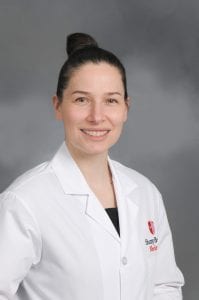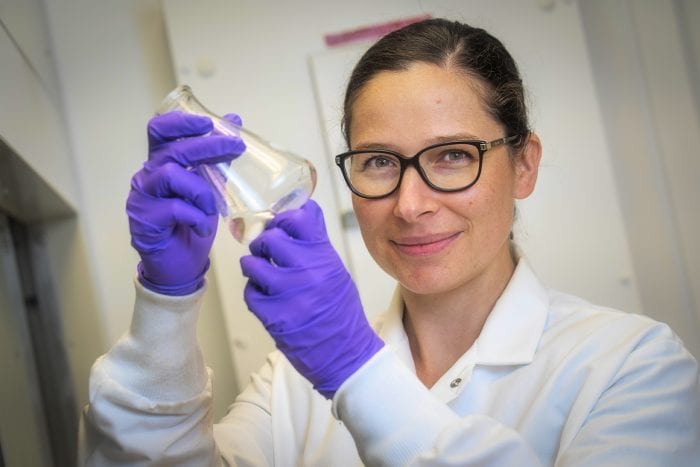By Daniel Dunaief
And the winner is … Eszter Boros. An Assistant Professor in the Department of Chemistry at Stony Brook University, Boros recently won the 2021 Stony Brook Discovery Prize, which includes $200,000 in new funding.
The prize, which was established in 2013, is designed to fund higher-risk research for scientists who are no more than five years beyond tenure and promotion at the Associate Professor level or who are on a tenure track as an Assistant Professor. The research might not otherwise receive financial support from agencies like the National Institutes of Health.

Stony Brook awards the prize to a faculty member who is considered a rising star.
Boros’s proposal suggests using a radioactive light switch to activate anticancer molecules.
The goal behind Boros’s work is to target cancer cells in particular, while avoiding the kinds of painful side effects that typically accompany chemotherapy, which can lead to gastrointestinal discomfort and hair loss, among others.
Boros, who has been at Stony Brook since 2017, was pleased to win the award. “It’s really exciting,” she said. “I’m kind of in disbelief. I thought all the finalists had convincing and exciting projects.”
The four finalists, who included Eric Brouzes in biomedical engineering, Gregory Henkes in geosciences and Kevin Reed in climate modeling, went through three rounds of screening, culminating in a Zoom-based 10-minute presentation in front of four judges.
Bruce Beutler, the Director of the Center for the Genetics of Host Defense at the University of Texas Southwestern Medical Center, served as one of the four judges.
In an email, Beutler wrote that Boros’s work had an “inventive approach” and was “high risk, but potentially high impact.”
Beutler, who won the 2011 Nobel Prize in Physiology and Medicine, suggested that the Discovery Prize may give a start to “a bright person with relatively little track record and a risky but well reasoned proposal.”
The success from such a distinction “does build on itself,” Beutler wrote. “Other scientists hear of such awards or read about them when evaluating future proposals. This may influence decisions about funding, or other awards, in the future.”
Boros said she would use the prize money to fund work from graduate students and post doctoral fellows, who will tackle the complexities of the work she proposed. She will also purchase supplies, including radioactive isotopes. She hopes to stretch the funds for two and a half or three years, depending on the progress she and the members of her lab make with the work.
The idea behind her research is to send radioactive materials that emit a light as they decay and that bind to the cancer cell. The light makes the chemotherapy toxic. Without that light, the chemotherapy would move around the body without damaging non-cancerous cells, reducing the drug’s side effects.
She is thinking of two ways to couple the radioactive light-emitting signal with an activated form of treatment. In the first, the two parts would not be selectively bound together.
The chemotherapy would diffuse into tissues around the body and would only become activated at the target site. This may affect healthy neighbors, but it wouldn’t cause as many side effects as conventional chemotherapy. This could take advantage of already clinically used agents that she can combine.
In the second strategy, she is taking what she described as a “next level” approach, in which she’d make the radioactive agent and the chemotherapy react with one another selectively. Once they saw one another, they would become chemically linked, searching to find and destroy cancer cells. This approach would require new chemistry which her lab would have to develop.
Beutler suggested that Boros’s work might have other applications, even if cancer might currently be the best one. Some focal but infectious diseases can be treated with antimicrobial therapy which, like cancer directed chemotherapy, is toxic, he explained.
The same principle of using a drug activated by light that is connected to a site-specific marker “could be used in such cases,” he said.
While the potential bench-to-bedside process for any single treatment or approach can seem lengthy and filled with unexpected obstacles, Beutler said he has seen certain cancers that were formerly fatal yield to innovation. “People who are battling cancer can at least be hopeful that their cancer might fall into this category,” he said.
Boros appreciated the opportunity to apply for the award, to bond with her fellow finalists and to benefit from a process that included several sessions with experts at the Alan Alda Center for Communicating Science, who helped prepare her for the presentation in front of the judges. She developed her full proposal during the course of a week, over the December holiday, when her lab had some down time.
In the final stage, she met weekly for an hour with Louisa Johnson, an Improvisation Lecturer at the Alda Center and Radha Ganesan, an Assistant Professor of Medicine, to hone her presentation.
Boros said she appreciated how the Alda Center guides helped her focus on the obsession she and other scientists sometimes have of putting too much text in her slides. “I put text and conclusions on every slide,” she said. Ganesan and Johnson urged her to focus on what she wants to say, while letting go of this urge to clutter her presentation with the same words she planned to use in her presentation. “That was a huge shift in mindset that I had to make,” she said.
As for the work this prize will help fund, Boros said she’ll start with targets she knows based on some research she’s already done with prostate, breast and ovarian cancers.
Boros, who was born and raised in Switzerland, described herself as a chemist at heart.
Outside of work, she enjoys spending time with her husband Labros Meimetis, Assistant Professor of Radiology at the Renaissance School of Medicine at Stony Brook, and their nine-month-old son.





